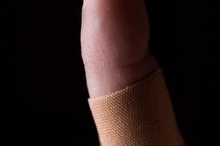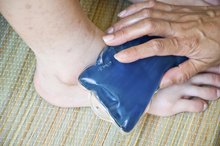Ring Finger Hurts After Bending it From Catching a Football
If your ring finger hurts after you have caught a football, you may have done more than jammed it; you may have broken it. A jammed finger occurs when there is impact to the finger, typically at the end of the finger, that results in pain and swelling at one of the joints. If the impact is hard enough, you could experience a break in one of the bones in the finger, again around one of the joints. Catching a football on the end of your ring finger can be painful and could sideline you for a few weeks.
If you are experiencing serious medical symptoms, seek emergency treatment immediately.
Diagnosing a Break
When it first occurs, a broken finger and a jammed finger can feel very much alike. Both can include pain and swelling. Unless the break is severe, you may not be able to tell if it's broken until the finger is X-rayed and examined by a doctor. Pain and swelling that does not subside within a day or two is often an indicator that the finger is broken, and not just jammed. Difficulty bending the finger is also a common sign that there is a break. If this happens to you, be honest with your doctor about how it happened and the extent of the pain, and follow his advice carefully to make sure it heals successfully.
- When it first occurs, a broken finger and a jammed finger can feel very much alike.
- Pain and swelling that does not subside within a day or two is often an indicator that the finger is broken, and not just jammed.
Treatment
The Duration of a Broken Finger
Learn More
Before you get a proper diagnosis, you should ice your injured finger immediately and elevate it as much as possible above your heart to minimize swelling. Unless the injury proves to be a serious break that might require surgery, your treatment plan will likely be a padded splint that fits over the top and bottom of the finger. A tendon injury to the finger will be similarly treated 1. That will be taped around your injured ring finger and then that ring finger will be taped to your middle finger to give it support and stability while it heals.
- Before you get a proper diagnosis, you should ice your injured finger immediately and elevate it as much as possible above your heart to minimize swelling.
Precautions
The best way to catch a football is to keep all your fingers slightly bent. Have your hands out in front of you with your thumbs and forefingers almost touching. Think of yourself pulling the ball in to the space between your hands and tucking it under one arm as you catch it. Be sure to keep your eye on the ball at all times as you reach out to catch it. Your chances of not having your fingers in the right position at the right time are increased if you take your eye off the ball and don't anticipate it correctly.
- The best way to catch a football is to keep all your fingers slightly bent.
- Think of yourself pulling the ball in to the space between your hands and tucking it under one arm as you catch it.
Other Considerations
How to Realign a Broken Nose
Learn More
If you do jam your ring finger and you're wearing a ring at the time, take it off immediately before swelling begins. Having a tight ring on can impede circulation, make the swelling worse and may require that the ring be cut off in order to relieve pressure in the injured digit. In general, you shouldn't wear rings while you play any sport, particularly one where there is a danger of jamming a finger.
Related Articles
References
- Lee's Summit Medical Center: Finger Extensor Tendon Injury
- Kidzworld.com: Quiz the Coach -- I Can't Catch
- Carruthers KH, Skie M, Jain M. Jam injuries of the finger: diagnosis and management of injuries to the interphalangeal joints across multiple sports and levels of experience. Sports Health. 2016;8(5):469-78. doi:10.1177/1941738116658643
- American Society for Surgery of the Hand. Jammed finger. 2015.
- Won SH, Lee S, Chung CY, et al. Buddy taping: is it a safe method for treatment of finger and toe injuries?. Clin Orthop Surg. 2014;6(1):26-31. doi:10.4055/cios.2014.6.1.26
Writer Bio
James Roland started writing professionally in 1987. A former reporter and editor with the "Sarasota Herald-Tribune," he currently oversees such publications as the "Cleveland Clinic Heart Advisor" and UCLA's "Healthy Years." Roland earned his Bachelor of Science in journalism from the University of Oregon.









